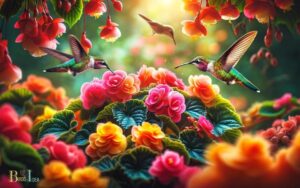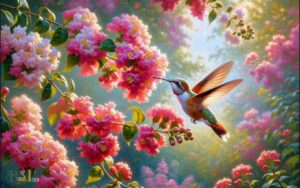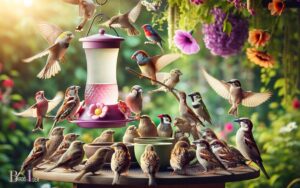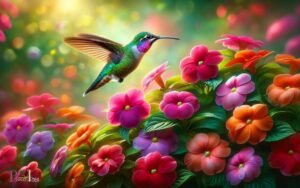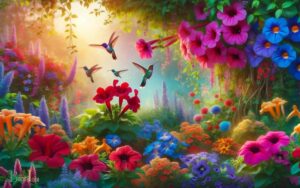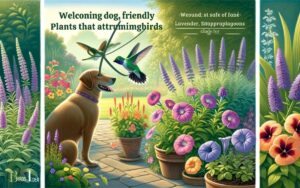Plants and Flowers That Attract Hummingbirds: Zinnias!
To attract hummingbirds, plant vibrant, nectar-rich flowers such as bee balm, zinnias, salvia, and bleeding hearts. Opt for tubular shapes that accommodate their feeding style, and avoid pesticides that harm these pollinators.
Hummingbirds are drawn to gardens that offer an abundance of nectar-producing flowers.
The flowers best suited to attract these birds typically share certain characteristics:
Here are some popular plants known for attracting hummingbirds:
Additionally, providing a water source and minimizing pesticide use can create a hospitable environment for hummingbirds.
Creating a hummingbird-friendly garden with appropriate plants not only offers these birds vital nourishment but also brings dynamic beauty and activity to your space.
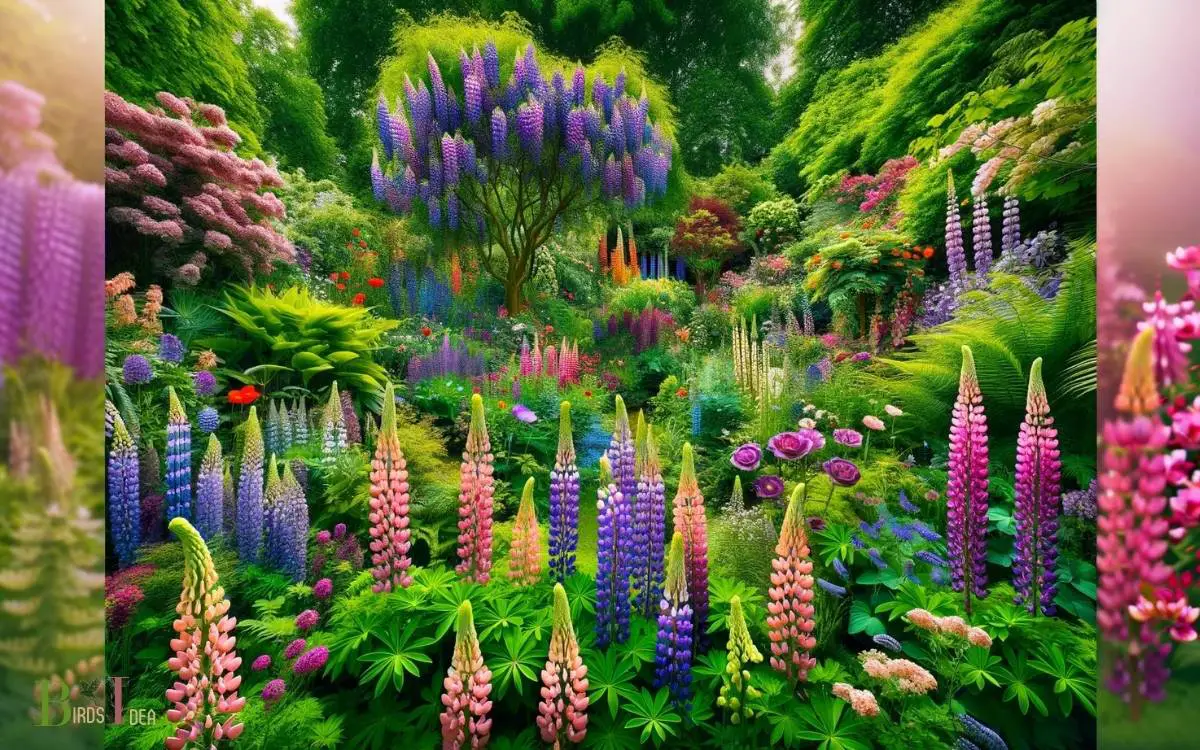
Key Takeaway
Choosing the Right Flowers
The selection of the right flowers is crucial for attracting hummingbirds to your garden. Hummingbirds are naturally drawn to brightly colored flowers, especially those that are red, orange, or pink.
They have a keen sense of sight and are particularly attracted to tubular-shaped flowers that hold nectar, such as trumpet vine, bee balm, and salvia.
It’s important to choose flowers that bloom at different times throughout the year to provide a consistent food source for the hummingbirds.
Additionally, opting for native flowers can significantly increase the chances of attracting these delightful birds to your garden, as they have co-evolved with the native flora.
By carefully selecting a variety of flowers that meet these criteria, you can create a hospitable environment that will entice hummingbirds to visit your garden regularly and delight you with their presence.
Native Plants for Hummingbirds
Native plants play a crucial role in attracting hummingbirds to your garden, as they have evolved alongside these birds and provide an essential food source.
When selecting native plants to attract hummingbirds, consider the following:
- Regional Varieties: Choose native plants that are indigenous to your specific region, as they are well-suited to the local climate and soil conditions, making them more attractive to hummingbirds.
- Blooming Seasons: Select a variety of native plants that bloom at different times throughout the year to provide a continuous nectar source for hummingbirds.
- Diversity of Flowers: Incorporate a mix of native plants with different flower shapes, sizes, and colors to appeal to a wide range of hummingbird species.
Perennials for Hummingbird Gardens
When selecting perennials for hummingbird gardens, gardeners should consider perennial varieties that are well-suited to their local climate and soil conditions, providing a continuous nectar source throughout the year.
Some popular perennials for hummingbirds include bee balm, columbine, salvia, and penstemon. Bee balm, also known as Monarda, produces vibrant, nectar-rich blooms that hummingbirds find irresistible.
Columbine, with its unique, spurred flowers, is a favorite of hummingbirds, especially when planted in partial shade. Salvia, available in a variety of colors, is a long-blooming perennial that provides a reliable nectar source.
Penstemon, or beardtongue, is a versatile perennial that offers tubular flowers in an array of hues, attracting hummingbirds throughout the growing season. These perennials not only beautify the garden but also provide a consistent food source for hummingbirds.
Annuals That Attract Hummingbirds
An important consideration for attracting hummingbirds is planting annuals that provide a consistent nectar source.
Annual plants have a shorter lifespan, usually lasting for just one growing season, but they produce an abundance of vibrant flowers that can attract hummingbirds to your garden.
When selecting annuals to attract hummingbirds, consider the following:
- Brightly Colored Flowers: Choose annuals with red, orange, or pink tubular flowers, as these colors are most attractive to hummingbirds.
- Continuous Blooming: Select annuals that have a prolonged blooming period to ensure a consistent nectar source for visiting hummingbirds throughout the growing season.
- Low-Maintenance Varieties: Opt for low-maintenance annuals that are easy to care for and can thrive in your specific climate and growing conditions.
Shrubs and Trees Loved by Hummingbirds
The shrubs and trees that attract hummingbirds provide essential shelter and additional food sources for these tiny, energetic birds.
Shrubs such as the coral honeysuckle, flowering quince, and butterfly bush are favored by hummingbirds for their nectar-rich flowers and protective cover.
Trees like the eastern red cedar, red buckeye, and trumpet vine also offer sturdy perches and nesting spots for these delightful creatures.
When selecting shrubs and trees to attract hummingbirds, it’s important to consider varieties that bloom at different times throughout the year to provide a continuous supply of nectar.
Additionally, incorporating a mix of evergreen and deciduous plants can ensure year-round habitat and foraging opportunities for hummingbirds.
By planting a diverse array of shrubs and trees, enthusiasts can create a welcoming environment that entices these charming birds to visit and stay.
Creating a Hummingbird Habitat
Creating a hummingbird habitat involves selecting ideal plant species, providing water and feeders, and offering shelter and perches. These three key points are essential for attracting and maintaining a thriving hummingbird population in a garden or outdoor space.
By carefully considering these elements, individuals can create an environment that is both attractive and beneficial to these delightful and energetic birds.
Ideal Plant Species
To create an ideal hummingbird habitat, gardeners can strategically plant specific species of flowers and plants that are known to attract and nourish these small birds.
- Trumpet Creeper: This vine produces vibrant, trumpet-shaped flowers that are rich in nectar, making it a favorite among hummingbirds.
- Bee Balm: With its colorful and fragrant blooms, bee balm is a great addition to a hummingbird garden. Its tubular flowers are well-suited for the long bills of hummingbirds.
- Cardinal Flower: Known for its striking red blooms, the cardinal flower is a magnet for hummingbirds.
Its tubular shape and copious nectar make it an essential plant for any hummingbird habitat. By incorporating these and other nectar-rich plants into their gardens, enthusiasts can create an inviting sanctuary for these delightful birds.
Water and Feeders
Strategically incorporating water sources and feeders into the garden can further enhance the hummingbird habitat, providing essential nourishment and hydration for these small birds.
Hummingbirds are attracted to the sound of moving water, so a small fountain or dripper can be an excellent addition to the garden.
Additionally, providing a shallow water source, such as a birdbath with pebbles for perching, can offer hummingbirds the opportunity to bathe and drink.
When it comes to feeders, it’s important to place them in shaded areas to prevent nectar spoilage and to refill them regularly, especially during hot weather.
Below is a table showcasing different types of water sources and feeders that can be included in a hummingbird-friendly garden:
| Water Sources | Feeders |
|---|---|
| Dripping Fountain | Saucer Feeder |
| Shallow Birdbath | Tube Feeder |
| Misting System | Dish Feeder |
| Water Dripper | Window Feeder |
Shelter and Perches
Enhancing the hummingbird habitat includes providing suitable shelter and perches for these small birds to rest and protect themselves.
Creating a welcoming environment for hummingbirds involves the following:
- Natural Shelter: Planting dense shrubs and trees offers hummingbirds protection from predators and harsh weather conditions. They seek refuge in these areas when not in flight.
- Artificial Shelters: Installing small, artificial shelters or nesting boxes can provide additional protection for hummingbirds, especially during nesting season.
- Perches: Adding perches throughout the habitat gives hummingbirds convenient resting spots. These perches can be as simple as small branches or decorative, purpose-built options.
Conclusion
Creating a hummingbird-friendly garden with the right plants and flowers can attract these beautiful birds to your yard. Did you know that hummingbirds have to eat half their body weight in nectar every day to stay alive?
By planting a variety of nectar-rich flowers, you can help support these amazing creatures and enjoy their presence in your garden. Happy gardening!

